
The third and current HMS Argyll is a Type 23 Duke-class frigate. She is currently the oldest serving Type 23 frigate in the Royal Navy. Like all of her class she is named after a British dukedom, in this case that of Argyll. HMS Argyll was laid down in March 1987 by Yarrow Shipbuilders at Glasgow, and launched in 1989 by Lady Wendy Levene, sponsored by the Worshipful Company of Paviors. She was commissioned in May 1991. Argyll is currently based at HMNB Devonport.
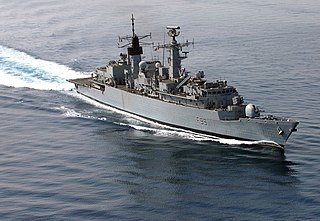
HMS Cornwall was a Batch 3 Type 22 frigate of the Royal Navy. She was the first Batch 3 to be built, and the last to decommission. Cornwall was based at HMNB Devonport in Devon, England, part of the Devonport Flotilla.

HMS Magnificent was one of the nine Majestic-class pre-dreadnought battleships of the Royal Navy. She entered service in late 1895 with the Channel Fleet, remaining with the fleet through its subsequent reorganisation into the Atlantic Fleet. In 1905, an explosion caused the deaths of 18 men but she remained in service until 1906, after which she underwent a refit. She served with the Home Fleet for most of her pre-war service.

HMS Triumph was a broadside ironclad battleship of the Victorian era, the sister-ship of HMS Swiftsure. These two ships comprise the Swiftsure class of 1870.

HMS Hussar was a Dryad-class torpedo gunboat of the Royal Navy. She was launched in 1894 and served in the Mediterranean between 1896 and 1905 before being used for fishery protection. During the Dardanelles campaign of 1915 her commanding officer and two of her ship's company won the Victoria Cross. She was broken up in 1921.
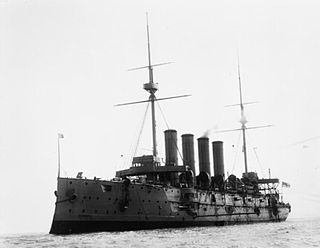
HMS Diadem was the lead ship of the Diadem-class of protected cruiser in the Royal Navy.

HMS Europa was a ship of the Diadem-class protected cruisers in the Royal Navy. She was built by J&G Thompson of Clydebank and launched on 20 March 1897.

HMS Blake, named in honour of Admiral Robert Blake, was the lead ship of her class of protected cruiser that served in the Royal Navy from 1889 to 1922.

HMS Windsor Castle was a triple-decker, 102-gun first-rate Royal Navy ship of the line. She was renamed HMS Cambridge in 1869, when she replaced a ship of the same name as gunnery ship off Plymouth.

Her Majesty's Naval Base, Devonport is one of three operating bases in the United Kingdom for the Royal Navy and is the sole nuclear repair and refuelling facility for the Royal Navy. The largest naval base in Western Europe, HMNB Devonport is located in Devonport, in the west of the city of Plymouth, England.

Admiral of the Fleet Sir Cecil Burney, 1st Baronet, was a Royal Navy officer. After seeing action as a junior office in naval brigades during both the Anglo-Egyptian War and the Mahdist War, he commanded a cruiser in operational service during the Second Boer War. As a flag officer he commanded the Plymouth Division of the Home Fleet, the 5th Cruiser Squadron, the Atlantic Fleet and then the 3rd Battle Squadron.

HMS Nile was a two-deck 90-gun second-rate ship of the line of the Royal Navy, launched on 28 June 1839 at Plymouth Dockyard. She was named to commemorate the Battle of the Nile in 1798. After service in the Baltic Sea and the North America and West Indies Station, she was converted to a training ship and renamed HMS Conway, surviving in that role until 1953.
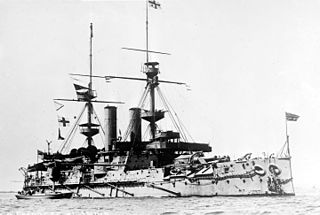
HMS Empress of India was one of seven Royal Sovereign-class pre-dreadnought battleships built for the Royal Navy during the 1890s. The ship was commissioned in 1893 and served as the flagship of the second-in-command of the Channel Fleet for two years. She was transferred to the Mediterranean Fleet in 1897, during which time Empress of India was assigned to the International Squadron blockading Crete during the uprising there. She returned home in 1901 and was briefly assigned as a coast guard ship in Ireland before she became the second flagship of the Home Fleet. The ship was reduced to reserve in 1905 and accidentally collided with the submarine HMS A10 the following year. Empress of India was taken out of service in early 1912 and accidentally struck a German sailing ship while under tow. She was sunk as a target ship in 1913.

HMS Highflyer was the lead ship of the Highflyer-class protected cruisers built for the Royal Navy in the 1890s. She spent her early career as flagship for the East Indies and North America and West Indies Stations. She was reduced to reserve in 1908 before again becoming the flagship in the East Indies in 1911. She returned home two years later and became a training ship. When World War I began in August 1914, she was assigned to the 9th Cruiser Squadron in the Central Atlantic to intercept German commerce raiders and protect Allied shipping.
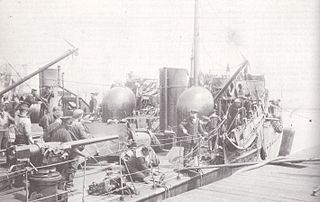
HMS Bittern was a Vickers three-funnel, 30-knot destroyer ordered by the Royal Navy under the 1895 – 1896 Naval Estimates. She was the fourth ship to carry this name since it was introduced in 1796 for an 18-gun sloop, sold in 1833.
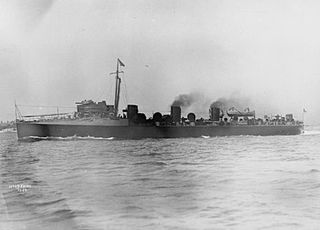
HMS Fairy was a three-funnel, 30-knot destroyer of the First World War. One of three similar ships built by Fairfields for the Royal Navy, she was ordered under the 1896–1897 Naval Estimates and the sixth Royal Navy ship to carry this name. She was classified, along with other similar ships, as a C-class destroyer in 1913. She sank in 1918 from damage inflicted by ramming and sinking the German submarine UC-75.
Five ships, one submarine and six shore establishments of the Royal Navy have borne the name HMS Vivid:

HMS Cambrian was a second-class protected cruiser, of the Royal Navy, built at the Pembroke Dockyard and launched on 30 January 1893. She was the last flagship of the Australia Station.
Admiral Harry Seawell Frank Niblett, CVO was a Royal Navy officer before the First World War.
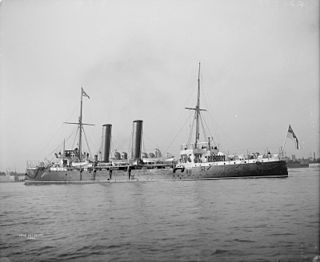
HMS Intrepid was an Apollo-class protected cruiser of the Royal Navy built on the River Clyde and launched in 1891. She was subsequently converted as a minelayer and sunk as a blockship during the Zeebrugge Raid on 23 April 1918.

















